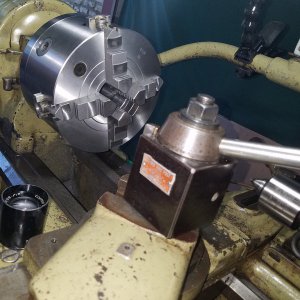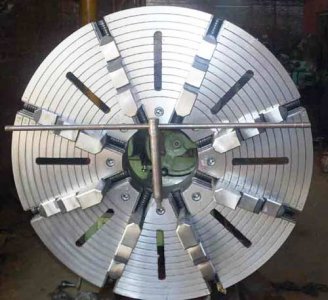-
Welcome back Guest! Did you know you can mentor other members here at H-M? If not, please check out our Relaunch of Hobby Machinist Mentoring Program!
You are using an out of date browser. It may not display this or other websites correctly.
You should upgrade or use an alternative browser.
You should upgrade or use an alternative browser.
When to use a 3 jaw chuck vs 4 jaw chuck. Choices.
- Thread starter CDarby67
- Start date
- Joined
- Nov 5, 2016
- Messages
- 1,420
It's been my experience that a four jaw chuck has better work holding potential because you have four gripping surfaces (vs 3) and these are opposed to each other (facing each other) for better gripping power. So, if you need to hold onto the very edge/end of a work piece, the 4 jaw has a better chance of holding it without it becoming airborne!
When I was a tool maker, we had four lathes and 3 jaw chucks were VERY seldom used. From daily use, everyone got pretty fast at dialing thing in.
Ted
When I was a tool maker, we had four lathes and 3 jaw chucks were VERY seldom used. From daily use, everyone got pretty fast at dialing thing in.
Ted
- Joined
- Dec 20, 2012
- Messages
- 9,422
All the above. I just wanted to clarify that when you first turn a work piece in a 3 jaw chuck, the result will be concentric with the centerline of the lathe; this is called a first operation. Most stock is not round to begin with and dialing it in in a 4 jaw for a first op turning is not necessary. Once you turn that piece and remove it from the chuck then you need a way to accurately dial it back in to the lathe centerline if further work needs to be done to it; this is called second operation work. This is when a 4 jaw independent chuck is most useful. The 4 jaw is also used to mount a work piece off center. Collet chucks are also commonly used on second operation work, especially if the part is threaded or delicate/thin-walled.
Most of my work is first operation stuff so I use a 3 jaw most often. If I do a second op on it then I am more likely to stick it in a collet chuck. I use a 4 jaw independent when I need to really minimize run out on the part and I'm not clamping on a threaded section. If I had to choose chucks, I would get a 3 jaw for most work and a 4 jaw independent. Leave the collet chucks for later.
Most of my work is first operation stuff so I use a 3 jaw most often. If I do a second op on it then I am more likely to stick it in a collet chuck. I use a 4 jaw independent when I need to really minimize run out on the part and I'm not clamping on a threaded section. If I had to choose chucks, I would get a 3 jaw for most work and a 4 jaw independent. Leave the collet chucks for later.
Mikey,
Is there a video you can recommend to help me learn about using 4 jaw chucks when doing second op work? Collet chucks are out of my skill set - I am a complete beginner, however, I have need of them as you mention. Most of what I will be making are (relative of course) thin wall parts.
Thanks,
Clint
Is there a video you can recommend to help me learn about using 4 jaw chucks when doing second op work? Collet chucks are out of my skill set - I am a complete beginner, however, I have need of them as you mention. Most of what I will be making are (relative of course) thin wall parts.
Thanks,
Clint
- Joined
- Apr 14, 2014
- Messages
- 3,534
Here's a link to a video by mrpete222 (Tubalcain) setting up a 4 jaw chuck.
- Joined
- Dec 20, 2012
- Messages
- 9,422
Mikey,
Is there a video you can recommend to help me learn about using 4 jaw chucks when doing second op work? Collet chucks are out of my skill set - I am a complete beginner, however, I have need of them as you mention. Most of what I will be making are (relative of course) thin wall parts.
Thanks,
Clint
The video from Mr. Pete is a good one. If you own a 4 jaw chuck, learn to use it well. With patience and skill, it will be the most accurate chuck in your shop. However, if you are going to work on a lot of thin-walled stuff then a collet chuck is the appropriate work holding method for you. Depending on your lathe and the size of your work, this might be a 5C or ER collet system. If the work is large then a 6 jaw chuck might be the answer. More details would help us to help you.
Forget the 8 jaw chuck - we'll all go over to Will's house and use his!
- Joined
- Apr 14, 2014
- Messages
- 3,534
I have a variety of chucks for both lathes. Both originally came with a 3 jaw and a 4 jaw chuck. Since then I have added 5C collet chucks for both and a number of different size 4 jaw chucks. By far the most used are the 4 jaw chucks. Second most used are the collet chucks, with the 3 jaw chucks pulling in a distant 3rd.
Sometimes using the jaws for indexing using a lathe dog. A four jaw you can make a double start or four (four not used much) and with the three jaw you can make a triple start thread. Turn a centre and place in the chuck using a lathe dog being indexed using the jaws. Done between centres.



